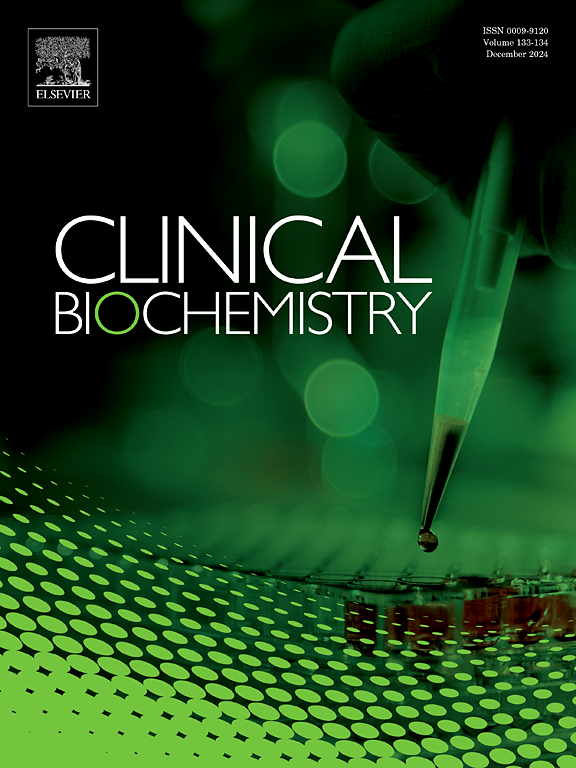溶血对脂肪酶结果的浓度依赖性影响:是否有临床意义?
IF 2.1
3区 医学
Q2 MEDICAL LABORATORY TECHNOLOGY
引用次数: 0
摘要
罗氏脂肪酶检测的溶血指数(HI)干扰阈值最近在包装说明书中从1000 (10 g/L血红蛋白)降低到100 (1 g/L血红蛋白),但提供的数据有限,无法支持这一变化。阈值的降低可能会增加重新收集率,扰乱实验室工作流程并改变结果解释。我们进行了干扰研究,以验证新制造商在临床相关脂肪酶浓度下的HI声明。方法观察肝素锂血浆中5种脂肪酶浓度(36 ~ 227 U/L;n = 3 - 5)加入不同血红蛋白浓度(0、0.5、1、2、3、4、5、8、10、12 g/L)的溶血物。在Roche Cobas c503分析仪上分别测定三次重复和单次重复的脂肪酶浓度和HI,并计算重复的均值和标准差。干扰被量化为与0 g/L对照的绝对和百分比差异,然后与几个公布的总允许误差(TEa)阈值进行比较。结果在1 g/L血红蛋白中,所有脂肪酶浓度的HI为95±4,与基线相差0.4 - 1.0%。根据使用的TEa标准,最低脂肪酶浓度组(38±2 U/L)要么表现出显著的(p <;0.05)血红蛋白从3 g/L开始升高(HI = 289±18)或12 g/L血红蛋白无差异(HI = 1171±22)。所有观察到的差异都在其他脂肪酶浓度的TEa限制范围内。结论溶血对脂肪酶的影响呈浓度依赖性,仅在脂肪酶浓度≤40 U/L时才有显著影响。本研究强调验证新制造商声明的重要性和评估临床变化影响的价值。本文章由计算机程序翻译,如有差异,请以英文原文为准。
Concentration dependent impact of hemolysis on lipase result: Does it clinically matter?
Background
The hemolysis index (HI) interference threshold for the Roche lipase assay was recently decreased in the package insert from 1000 (10 g/L hemoglobin) to 100 (1 g/L hemoglobin), but limited data was provided to support the change. A decrease in the threshold could increase re-collection rates, disrupt laboratory workflow and change result interpretation. We performed interference studies to verify the new manufacturer HI claim at clinically relevant lipase concentrations.
Methods
Five lipase concentrations in lithium heparin plasma (36–227 U/L; n = 3–5) were spiked with hemolysates of varying hemoglobin concentrations (0, 0.5, 1, 2, 3, 4, 5, 8, 10, 12 g/L). Lipase concentrations and HI were measured on the Roche Cobas c503 analyzer in triplicate and singleton, respectively, and means and standard deviations of replicates were calculated. Interference was quantified as the absolute and percent differences from the 0 g/L control, then compared against several published total allowable error (TEa) thresholds.
Results
At 1 g/L hemoglobin, the HI was 95 ± 4 and yielded a 0.4–1.0 % difference from baseline across all lipase concentrations. Depending on the TEa criteria used, the lowest lipase concentration group (38 ± 2 U/L) either exhibited significantly (p < 0.05) elevated results starting at 3 g/L hemoglobin (HI = 289 ± 18) or no difference up to 12 g/L hemoglobin (HI = 1171 ± 22). All observed differences were within TEa limits for other lipase concentrations.
Conclusion
Hemolysis affected lipase results in a concentration-dependent manner with an analytically significant impact only at lipase concentrations <40 U/L. This study stresses the importance of verifying new manufacturer claims and the value of assessing clinical change impact.
求助全文
通过发布文献求助,成功后即可免费获取论文全文。
去求助
来源期刊

Clinical biochemistry
医学-医学实验技术
CiteScore
5.10
自引率
0.00%
发文量
151
审稿时长
25 days
期刊介绍:
Clinical Biochemistry publishes articles relating to clinical chemistry, molecular biology and genetics, therapeutic drug monitoring and toxicology, laboratory immunology and laboratory medicine in general, with the focus on analytical and clinical investigation of laboratory tests in humans used for diagnosis, prognosis, treatment and therapy, and monitoring of disease.
 求助内容:
求助内容: 应助结果提醒方式:
应助结果提醒方式:


